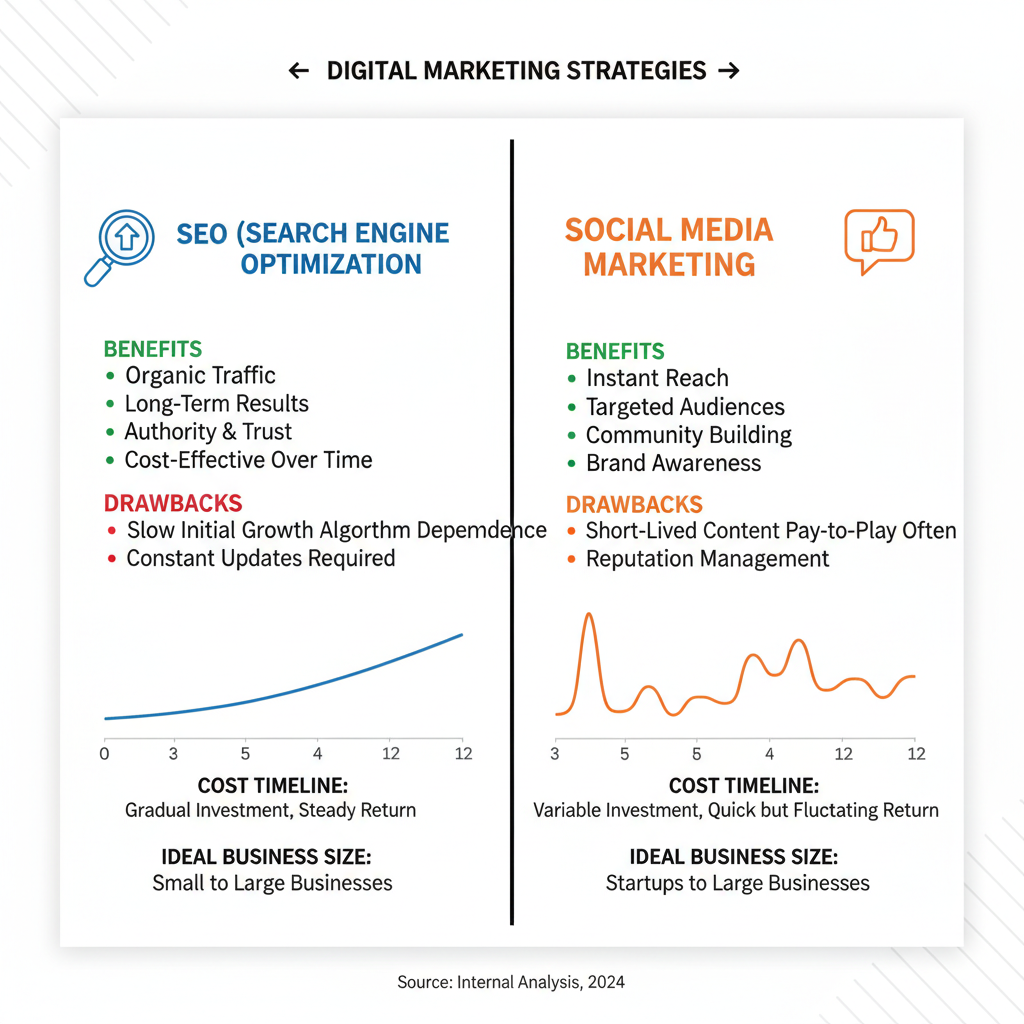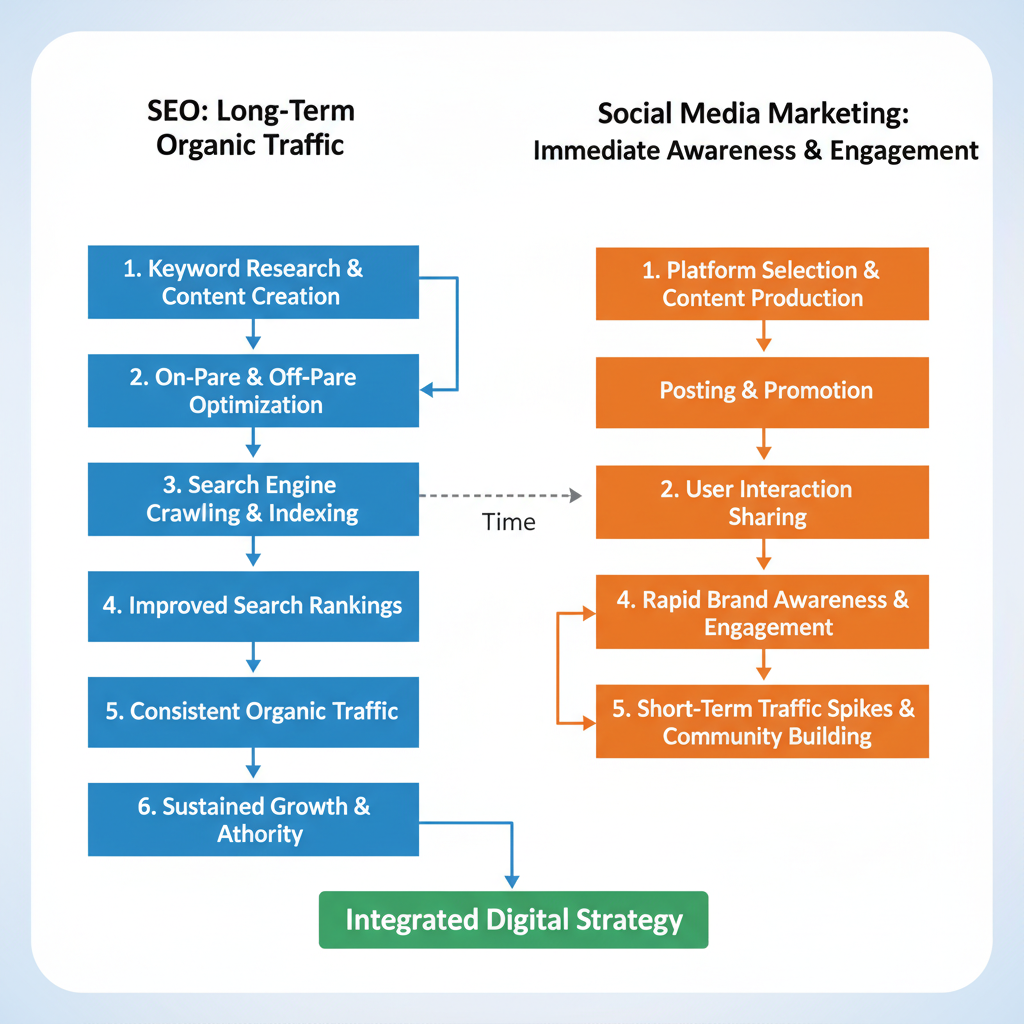SEO vs Social Media Marketing: Best Channel for Business Res
Learn the key differences between SEO and social media marketing, and discover which channel delivers better ROI, traffic, and brand visibility.

SEO vs Social Media Marketing: Choosing the Best Channel for Business Results
When business owners ask “SEO or social media marketing?”, they’re seeking to identify the digital channel that will deliver the highest impact for revenue growth and brand visibility. Understanding the strengths, limitations, and audience behaviors for each option helps make strategic decisions that drive measurable results.
In this guide, we’ll explore what SEO and social media marketing are, compare their core differences, examine benefits for different business sizes, and outline practical integration strategies — so you can choose the right balance to meet your goals.

---
What is SEO?
Search Engine Optimization (SEO) is the process of improving a website’s visibility in search engines like Google, Bing, or Yahoo. It involves optimizing on-page content, technical performance, and backlink profiles to gain higher rankings for relevant keywords.
Core elements of SEO:
- On-page optimization: Keyword-focused content, strategic internal linking, and optimized meta tags.
- Technical SEO: Fast-loading pages, mobile-friendly usability, logical site architecture, and schema markup.
- Off-page optimization: Earn backlinks, secure mentions in digital PR, and build domain authority signals.
---
What is Social Media Marketing?
Social Media Marketing (SMM) uses platforms such as Facebook, Instagram, LinkedIn, TikTok, and X (Twitter) to connect with audiences through posts, paid ads, videos, and interactive campaigns.
Core elements of social marketing:
- Content creation: Eye-catching visuals, trending short videos, and authentic storytelling.
- Community management: Responding to comments, direct messages, and building brand communities.
- Ad campaigns: Paid promotions targeting demographics, interests, and behaviors.
---
Key Difference Between SEO and Social Media
While SEO attracts people actively searching for information or products, social media marketing engages an audience in discovery mode — often unaware they need your product until they see it.
| Factor | SEO | Social Media Marketing |
|---|---|---|
| Audience Intent | High intent – users searching with specific goals. | Mixed intent – users browsing, discovering, engaging casually. |
| Traffic Source | Organic search engines | Social network feeds and ads |
| Longevity | Long-term, compounding over time | Short-term, requires constant posts and ads |
| Measurement | Keyword rankings, organic traffic, conversion rates | Engagement, reach, followers, click-through rate |
---
How SEO Drives Long-Term Organic Traffic
SEO investments deliver compounding returns. Once you secure top positions for high-value keywords, steady traffic flows without paying per click — often for months or years if site quality remains strong.
Key points:
- Evergreen content continues to attract visitors long after publishing.
- A single high-ranking page can generate thousands of visits monthly.
- Organic visitors tend to have higher conversion rates due to strong purchase intent.

---
How Social Media Marketing Builds Brand Awareness and Engagement
Social media excels at real-time brand storytelling and fostering emotional connections. Campaigns can go viral, quickly amassing large audiences and humanizing the brand image.
Advantages of SMM for awareness:
- Access lookalike audiences via targeted ads.
- Use trending hashtags to amplify discoverability.
- Cultivate direct engagement through comments, shares, and live interactions.
The caveat: visibility drops when posting or ad spend stops.
---
Cost & ROI Timelines
| Aspect | SEO | Social Media |
|---|---|---|
| Initial Costs | High setup cost for site optimization and content creation | Variable ad spend; low setup cost for organic posting |
| Ongoing Costs | Content updates, technical audits, link building campaigns | Ongoing content creation, ad budget, social media management |
| ROI Timeline | 3–9 months or more to achieve substantial results | Immediate (ads) or short-term spikes from viral organic content |
---
Benefits & Drawbacks for Small vs Large Businesses
Small businesses often favor social media for quick awareness and audience building.
- Pros: Rapid reach via ads, budget flexibility, creative experimentation.
- Cons: Requires continuous spending; algorithm changes can reduce organic reach.
Large businesses tend to invest heavily in SEO for scalable, sustained traffic growth.
- Pros: Long-term traffic volume, stronger ROI over time.
- Cons: Significant ongoing needs for content and technical optimization.
---
Audience Intent Differences Between Search & Social
Audience intent significantly shapes strategies:
- Search (SEO): Visitors are actively seeking products or answers, making them more ready to buy or engage.
- Social (SMM): Visitors are passively browsing; conversion often requires nurturing and multiple touchpoints.
Understanding intent lets marketers tailor copy, calls-to-action, and conversion funnels more effectively.
---
Real-World Examples
SEO success:
A B2B SaaS brand produced targeted blog content for queries like “best project management tool for startups.” Eight months later, posts ranked top 3 in Google, generating 5,000+ monthly visits and converting at 7%.
Social media success:
A fashion boutique launched an Instagram Reel challenge. In 2 weeks, followers grew by 40%, and featured collection sales rose 25%.
---
Integration Strategies: Using Both Together
Effective marketers blend SEO and social media marketing for balanced impact.
Integration ideas:
- Transform SEO blog posts into bite-sized social videos for wider reach.
- Share optimized articles on LinkedIn to amplify professional credibility.
- Leverage social trends to inform new SEO keyword targets and content topics.

---
Tips for Choosing the Right Mix
Evaluate:
- Business stage – New brands can leverage social for quick visibility while building SEO foundations.
- Budget flexibility – SEO demands upfront and steady investment; social spend adapts more quickly.
- Industry competition – Highly competitive search terms may warrant an initial social-first strategy.
- Conversion goals – Prioritize SEO for purchase-intent goals; lean on social for awareness campaigns.
---
Metrics to Track for SEO vs Social Campaigns
To measure campaign success:
SEO metrics:
- Organic traffic volume
- Keyword ranking positions
- Bounce rate
- Conversion rate from organic clicks
Social media metrics:
- Engagement rate (likes, comments, shares)
- Reach & impressions
- Click-through rate (CTR) on posts/ads
- Follower growth trends
---
Final Thoughts and Next Steps
The SEO vs social media marketing decision is rarely binary. The most effective marketing strategies combine both — SEO for sustained, high-intent traffic and social for rapid brand building and engagement. Start with the channel that best fits your current goals and budget, then integrate the other to maximize long-term impact.
If you’re ready to grow your business, begin mapping your customer journey and decide where SEO and social can work together to deliver the strongest results.




